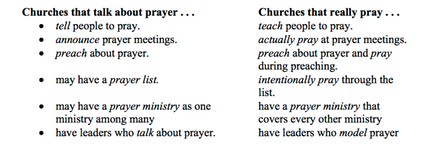Diagnose Your Church’s Health Is the Church a Praying Church?
By Chuck Lawless
This article is the third in a series dealing with questions to ask when consulting with a church. We addressed the first question, “Is the church’s teaching based on the Bible?” in last month’s article (http://chucklawless.com/wp-content/uploads/2015/question-1_bible-based.pdf ). The question for this month, “Is the church a praying church?” may well be the most important question of the eight questions we will ask.
Prayer is the means by which we get the power to grow a God-honoring church, and most church leaders are well aware of this truth. The problem, though, is this: most churches pray reactively rather than proactively. That is, they respond in prayer when a need develops, but they seldom take charge in prayer by seeking God’s face before a problem develops. Even our prayer lists reflect this tendency, as we include on the list primarily those who have made known their need for prayer.
In my book, Discipled Warriors, I compare “churches that talk about prayer” with “churches that really pray.” Perhaps this comparison is a starting point to evaluate whether a church is a praying church:

Here are some other ways to determine whether a church is a praying church:
- Ask the pastor about his personal prayer life. This question is often a difficult one to ask, as you are putting the pastor on the spot. Nevertheless, we know from our research and our consulting experience that a local church seldom prays more fervently than the pastor does. If the pastor struggles with prayer, encourage him to secure an accountability partner who will hold him faithful to this important task. If he does not already have Pastor’s Prayer Partners who pray with him weekly, invite him to start now in enlisting some prayer warriors who intentionally cover his life and ministry in prayer.
- Conduct a church wide survey about prayer. How will you know if the church is a praying church unless you ask the members about their own prayer lives? Two possible resources are the Church Health Survey (see the link above on this webpage)
Lawless
and Serving in Your Church Prayer Ministry, a small book that includes a reproducible prayer survey.
- Determine if the church has a prayer “point person.” The titles for this role differ (e.g., prayer director, minister of prayer, prayer leader, prayer coordinator), but churches that really pray typically have someone overseeing an intentional prayer ministry. If no one is in charge of keeping prayer on the church’s agenda, prayer almost always gets pushed aside.
- Ask if the church has a prayer room. Obviously, having a place for prayer is no guarantee that the church is a praying church. It might be that the church has a prayer room that few people use. Yet, churches that intentionally set aside a room for the purpose of prayer tend to be more committed to praying.
- See if the church’s small groups have assigned prayer leaders for each group. The small group is the place that most relationships develop, and it is in that context that many church members share their prayer needs. If, however, no one in the small group is responsible for recording those needs and encouraging members to pray, those needs often fall on inattentive ears. Each small group should have a prayer leader who takes responsibility for recording needs, inviting others to pray, and reporting the results when God answers those prayers.
- If the church has a membership class, ask how much attention is given to teaching new members how to pray. Most membership classes are not long enough to do much in-depth teaching, but some time should nevertheless focus on helping new believers and members to develop their spiritual disciplines. Seldom are members more ready to take on these tasks than when they first become a believer or a new member.
- Determine how often the church gathers solely for the purpose of prayer. Every church I know prays together at some point, but those prayer times are often simply an expected part of a routine worship service. We pray simply because it is time to pray in the order of worship. A praying church, though, gathers often only to pray— focusing on God, the needs of the church, and the needs of non-believers in the community. Prayer is by no means just routine in these churches.
As you consult with churches, don’t ignore this vital component of prayer. Instead, challenge churches to begin their work in prayer, support it through prayer, and praise God in prayer when He blesses their work! Keep in mind these other resources that might help you: And the Place was Shaken (John Franklin), A House of Prayer (John Franklin), The Praying Church Sourcebook (Alvin Vander Griend), and The Praying Church Idea Book (Douglas Kamstra).
Source: http://chucklawless.com/wp-content/uploads/2015/question-2_praying-churches.pdf



